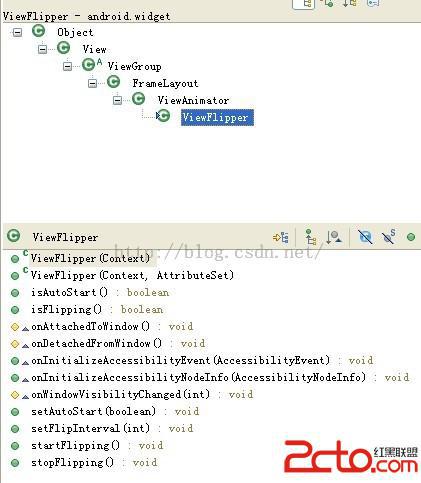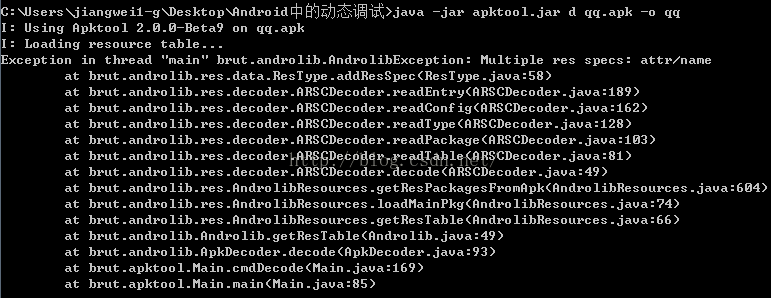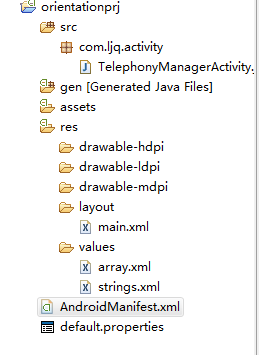編輯:關於Android編程
mVfFlipper.addView(child, index);

setInAnimation:設置View進入屏幕時候使用的動畫,該函數有兩個版本,一個接受單個參數,類型為android.view.animation.Animation;一個接受兩個參數,類型為Context和int,分別為Context對象和定義Animation的resourceID。
setOutAnimation: 設置View退出屏幕時候使用的動畫,參數setInAnimation函數一樣。
showNext: 調用該函數來顯示FrameLayout裡面的下一個View。
showPrevious: 調用該函數來顯示FrameLayout裡面的上一個View。
/*
* Copyright (C) 2006 The Android Open Source Project
*
* Licensed under the Apache License, Version 2.0 (the "License");
* you may not use this file except in compliance with the License.
* You may obtain a copy of the License at
*
* http://www.apache.org/licenses/LICENSE-2.0
*
* Unless required by applicable law or agreed to in writing, software
* distributed under the License is distributed on an "AS IS" BASIS,
* WITHOUT WARRANTIES OR CONDITIONS OF ANY KIND, either express or implied.
* See the License for the specific language governing permissions and
* limitations under the License.
*/
package android.widget;
import android.content.BroadcastReceiver;
import android.content.Context;
import android.content.Intent;
import android.content.IntentFilter;
import android.content.res.TypedArray;
import android.os.Handler;
import android.os.Message;
import android.util.AttributeSet;
import android.util.Log;
import android.view.accessibility.AccessibilityEvent;
import android.view.accessibility.AccessibilityNodeInfo;
import android.widget.RemoteViews.RemoteView;
/**
* Simple {@link ViewAnimator} that will animate between two or more views
* that have been added to it. Only one child is shown at a time. If
* requested, can automatically flip between each child at a regular interval.
*
* @attr ref android.R.styleable#ViewFlipper_flipInterval
* @attr ref android.R.styleable#ViewFlipper_autoStart
*/
@RemoteView
public class ViewFlipper extends ViewAnimator {
private static final String TAG = "ViewFlipper";
private static final boolean LOGD = false;
private static final int DEFAULT_INTERVAL = 3000;
private int mFlipInterval = DEFAULT_INTERVAL;
private boolean mAutoStart = false;
private boolean mRunning = false;
private boolean mStarted = false;
private boolean mVisible = false;
private boolean mUserPresent = true;
public ViewFlipper(Context context) {
super(context);
}
public ViewFlipper(Context context, AttributeSet attrs) {
super(context, attrs);
TypedArray a = context.obtainStyledAttributes(attrs,
com.android.internal.R.styleable.ViewFlipper);
mFlipInterval = a.getInt(
com.android.internal.R.styleable.ViewFlipper_flipInterval, DEFAULT_INTERVAL);
mAutoStart = a.getBoolean(
com.android.internal.R.styleable.ViewFlipper_autoStart, false);
a.recycle();
}
private final BroadcastReceiver mReceiver = new BroadcastReceiver() {
@Override
public void onReceive(Context context, Intent intent) {
final String action = intent.getAction();
if (Intent.ACTION_SCREEN_OFF.equals(action)) {
mUserPresent = false;
updateRunning();
} else if (Intent.ACTION_USER_PRESENT.equals(action)) {
mUserPresent = true;
updateRunning(false);
}
}
};
@Override
protected void onAttachedToWindow() {
super.onAttachedToWindow();
// Listen for broadcasts related to user-presence
final IntentFilter filter = new IntentFilter();
filter.addAction(Intent.ACTION_SCREEN_OFF);
filter.addAction(Intent.ACTION_USER_PRESENT);
getContext().registerReceiver(mReceiver, filter);
if (mAutoStart) {
// Automatically start when requested
startFlipping();
}
}
@Override
protected void onDetachedFromWindow() {
super.onDetachedFromWindow();
mVisible = false;
getContext().unregisterReceiver(mReceiver);
updateRunning();
}
@Override
protected void onWindowVisibilityChanged(int visibility) {
super.onWindowVisibilityChanged(visibility);
mVisible = visibility == VISIBLE;
updateRunning(false);
}
/**
* How long to wait before flipping to the next view
*
* @param milliseconds
* time in milliseconds
*/
@android.view.RemotableViewMethod
public void setFlipInterval(int milliseconds) {
mFlipInterval = milliseconds;
}
/**
* Start a timer to cycle through child views
*/
public void startFlipping() {
mStarted = true;
updateRunning();
}
/**
* No more flips
*/
public void stopFlipping() {
mStarted = false;
updateRunning();
}
@Override
public void onInitializeAccessibilityEvent(AccessibilityEvent event) {
super.onInitializeAccessibilityEvent(event);
event.setClassName(ViewFlipper.class.getName());
}
@Override
public void onInitializeAccessibilityNodeInfo(AccessibilityNodeInfo info) {
super.onInitializeAccessibilityNodeInfo(info);
info.setClassName(ViewFlipper.class.getName());
}
/**
* Internal method to start or stop dispatching flip {@link Message} based
* on {@link #mRunning} and {@link #mVisible} state.
*/
private void updateRunning() {
updateRunning(true);
}
/**
* Internal method to start or stop dispatching flip {@link Message} based
* on {@link #mRunning} and {@link #mVisible} state.
*
* @param flipNow Determines whether or not to execute the animation now, in
* addition to queuing future flips. If omitted, defaults to
* true.
*/
private void updateRunning(boolean flipNow) {
boolean running = mVisible && mStarted && mUserPresent;
if (running != mRunning) {
if (running) {
showOnly(mWhichChild, flipNow);
Message msg = mHandler.obtainMessage(FLIP_MSG);
mHandler.sendMessageDelayed(msg, mFlipInterval);
} else {
mHandler.removeMessages(FLIP_MSG);
}
mRunning = running;
}
if (LOGD) {
Log.d(TAG, "updateRunning() mVisible=" + mVisible + ", mStarted=" + mStarted
+ ", mUserPresent=" + mUserPresent + ", mRunning=" + mRunning);
}
}
/**
* Returns true if the child views are flipping.
*/
public boolean isFlipping() {
return mStarted;
}
/**
* Set if this view automatically calls {@link #startFlipping()} when it
* becomes attached to a window.
*/
public void setAutoStart(boolean autoStart) {
mAutoStart = autoStart;
}
/**
* Returns true if this view automatically calls {@link #startFlipping()}
* when it becomes attached to a window.
*/
public boolean isAutoStart() {
return mAutoStart;
}
private final int FLIP_MSG = 1;
private final Handler mHandler = new Handler() {
@Override
public void handleMessage(Message msg) {
if (msg.what == FLIP_MSG) {
if (mRunning) {
showNext();
msg = obtainMessage(FLIP_MSG);
sendMessageDelayed(msg, mFlipInterval);
}
}
}
};
}
下載地址:點擊

 Android實現網絡加載時的對話框功能
Android實現網絡加載時的對話框功能
效果預覽簡要說明現在android程序網絡請求操作是必不可少的,然而擁有好的交互體驗的程序對網絡耗時操作的處理尤為重要。代碼說明:dialog_loading.xml&l
 Android逆向之旅---反編譯利器Apktool和Jadx源碼分析以及錯誤糾正
Android逆向之旅---反編譯利器Apktool和Jadx源碼分析以及錯誤糾正
一、前言在之前的破解過程中可以看到我們唯一離不開的一個神器那就是apktool了,這個工具多強大就不多說了,但是如果沒有他我們沒法涉及到後面的破解工作了,這個工具是開源的
 Android編程實現號碼歸屬地查詢的方法
Android編程實現號碼歸屬地查詢的方法
本文實例講述了Android編程實現號碼歸屬地查詢的方法。分享給大家供大家參考,具體如下:我們通過發送XML訪問 WebService就可以實現號碼的歸屬地查詢,我們可以
 Android中TelephonyManager類的用法案例詳解
Android中TelephonyManager類的用法案例詳解
本文以案例形式分析了Android中TelephonyManager類的用法。分享給大家供大家參考。具體如下:目錄結構:main.xml布局文件:<?xml